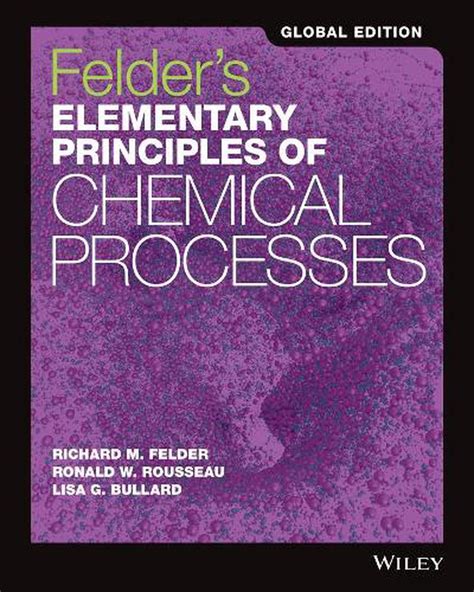Chemical processes play a pivotal role in countless industries, transforming raw materials into a staggering array of products essential to modern society. This comprehensive guide delves into the elementary principles that govern chemical processes, empowering you with a deep understanding of these fundamental concepts.

Matter and Its Structure
1. Composition of Matter:
Matter comprises atoms, the building blocks, which combine to form molecules or ions. Atoms contain a positively charged nucleus and negatively charged electrons.
2. Elements and Compounds:
Elements are unique substances composed of atoms with the same atomic number (number of protons). Compounds are formed when atoms of different elements combine chemically.
Chemical Reactions
1. Types of Chemical Reactions:
- Combination: Two or more substances combine to form a single product.
- Decomposition: A compound breaks down into simpler substances.
- Single replacement: An element replaces another element in a compound.
- Double replacement: Two compounds exchange ions.
2. Balancing Chemical Equations:
Chemical equations represent reactions symbolically. Balancing ensures that the number of atoms of each element is equal on both sides of the equation.
Stoichiometry
1. Mole Concept:
The mole is the standard unit of measurement for the amount of a substance. One mole contains 6.022 x 10^23 atoms or molecules.
2. Limiting Reactant:
In a chemical reaction, the reactant that is consumed first limits the amount of product that can be formed.
Energy Changes
1. Exothermic and Endothermic Reactions:
- Exothermic reactions release energy (heat) into the surroundings.
- Endothermic reactions absorb energy from the surroundings.
2. Enthalpy Change:
Enthalpy change (ΔH) measures the energy change that occurs during a reaction. For exothermic reactions, ΔH is negative, while for endothermic reactions, ΔH is positive.
Reaction Rates and Equilibrium
1. Reaction Rates:
Reaction rates measure the speed at which reactions occur. Factors that affect reaction rates include temperature, concentration, and surface area.
2. Equilibrium:
In some reactions, the forward and reverse reactions occur at equal rates, establishing a state of equilibrium. The equilibrium constant (K) quantifies the extent of the reaction.
Applications of Chemical Processes
The principles of chemical processes underpin countless applications across various sectors, including:
1. Manufacturing: Pharmaceuticals, chemicals, plastics, and more.
2. Energy: Fossil fuel refining, biofuel production, and nuclear reactions.
3. Environmental Protection: Water treatment, air pollution control, and waste management.
4. Agriculture: Fertilizers, pesticides, and genetic engineering.
5. Medicine: Drug development, diagnostics, and medical devices.
Developing New Chemical Processes
1. Reverse Engineering:
Analyze existing processes to identify areas for improvement.
2. Computer Simulations:
Model and optimize chemical processes using software tools.
3. Catalyst Development:
Discover or design catalysts to increase reaction efficiency.
4. Nanoengineering:
Utilize nanomaterials to create novel applications.
Tips and Tricks
- Use dimensional analysis to check your calculations.
- Pay close attention to the units of measurement.
- Study the periodic table to understand element properties.
- Practice balancing chemical equations regularly.
- Understand the concept of limiting reactants.
Comparison of Pros and Cons
| Method | Pros | Cons |
|---|---|---|
| Reverse Engineering | Time-saving, practical | May not yield significant improvements |
| Computer Simulations | Accurate, predicts behavior | Requires significant computational resources |
| Catalyst Development | Efficient processes, reduce energy costs | Can be costly and time-consuming |
| Nanoengineering | Novel applications, improved properties | Complex, expensive |
FAQs
1. What is the difference between an atom and a molecule?
An atom is a fundamental particle of matter, while a molecule is two or more atoms chemically bonded together.
2. Why is balancing chemical equations important?
Balancing ensures that the law of conservation of mass is obeyed, meaning that the number of atoms of each element remains the same throughout the reaction.
3. What factors affect reaction rates?
Temperature, concentration, surface area, and catalysts influence reaction rates.
4. What is enthalpy change?
Enthalpy change measures the energy change that occurs during a reaction, including both heat and work.
5. What is the purpose of a catalyst?
A catalyst increases the reaction rate without being consumed in the process.
6. How can chemical processes be applied in medicine?
Chemical processes are used in drug development, diagnostics, and medical device manufacturing.
7. What are the challenges in developing new chemical processes?
Challenges include high costs, environmental concerns, and regulatory requirements.
8. How can technology be used in chemical process development?
Computer simulations, machine learning, and nanotechnology play crucial roles in optimizing and innovating chemical processes.
